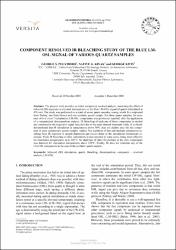Component resolved IR bleaching study of the blue LM-OSL signal of various quartz samples
Künye
Polymeris, G. S., Güneç Kıyak, N., & Kitis, G. (2008). Component resolved IR bleaching study of the blue LM-OSL signal of various quartz samples. Geochronometria, 32(1), 79-85. doi:10.2478/v10003-008-0028-3Özet
The present work provides an initial component resolved analysis concerning the effect of infra-red (IR) exposure at elevated temperatures on the blue LM-OSL signal of quartz (stimulated at 470 nm). The study was performed on a total of seven quartz samples, among which five originated from Turkey, one from Greece and one synthetic quartz sample. For these quartz samples, the presence of 6 or even 7 independent LM-OSL components was previously reported, after the application of a computerized decomposition analysis. IR bleaching of each one of these components is studied and compared to the respective signal reduction due to the same thermal treatment solely. It is clearly demonstrated that IR stimulation at temperatures above 50 degrees C does not deplete only the fast component in most sedimentary quartz samples studied. Net depletion of fast and medium components resulting from IR exposure is sample-dependent and occurs faster as the stimulation temperature increases. Weak IR bleaching of slow components is also reported in some cases, being more effective for stimulation temperatures up to 100 degrees C. No depletion of either the medium or the slow components was detected for stimulation temperatures above 150 degrees C. Finally, IR does not stimulate any of the LM-OSL components in the case of the synthetic quartz sample.


















